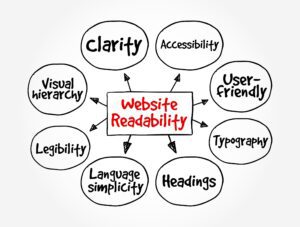
Does reading ease score matter in SEO content?

When you’re creating long-form content – especially blog content, think pieces and evergreen resources for an online audience – reading ease score is a useful, but often underestimated metric.
Now, more than ever, readers are fickle. As users favour ‘scanning’ their content, or will quickly bounce off pages that don’t serve their purpose within the first few seconds, ensuring your SEO content is as ‘readable’ as possible is crucial.
So, what is readability?

It might seem like a given, but ‘readability’ is all about how easy or hard it is for a reader to follow a piece of content.
Several different factors are considered as part of a readability score. These can include:
- Word choice
- Word complexity
- Sentence length
- Sentence structure
- The average amount of syllables per word
Together, they can help tools get a sense of how likely the piece is set to be understood by a reader. Remember, the average literacy age is 9 years old.

One of our content writers here at Embryo, Amelia Ward, adds:
“Good readability helps users easily digest the content.
Modern readers have increasingly low attention spans, so how smoothly a page reads is crucial for engaging users.
User experience is a known ranking factor, readability and skimmable content form a large chunk of this. Style, format and work count shouldn’t be overlooked when it comes to optimising content.”
How can we use it in SEO content?
Trying to improve the readability across your website improves the likelihood that the reader will fully understand the thoughts and concepts presented. A high readability score reduces the chances of misunderstanding and allows the user to fully process the article – without getting fed up and bouncing off the page.
As such, writing readable text can also improve your organic SEO. With Google now favouring human-led, useful content thanks to the quality-led E-E-A-T algorithm, readable text is key. And with the rise of voice search on the periphery, readable texts can also contribute to higher rankings in the SERPs.
How do I check my reading ease score?
In content marketing, readability is one of the cornerstones of production – mainly because it is a ‘make or break’ factor in how readers engage with your pieces.
Although you might be able to check as you go along or pass your work along for editing or peer review, it can be tricky to gauge how it would be perceived by a genuine user.
So – we turn to tech. The simplest and easiest way to make sure your writing is readable is to use a tool to help you automatically ‘grade’ its viability.
At Embryo, our team of in-house content experts is fond of the following tools.
Tools used by Embryo
The majority of these tools provide a readability score based on the Flesch reading ease test, which is a very well-known formula.

What is the Flesch-Kincaid readability score?
A popular method of reading ease scoring is called the Flesch Kincaid Grade Level. Through this, we determine a text’s approximate reading grade level based on word difficulty and average sentence length, generating a score that matches grade levels in the US.
Although there are several tests available, changing from tool to tool, the Flesch tests are arguably the most used, as it’s recommended for all sectors and disciplines.
The algorithm works off the average length of your sentences (measured by the number of words), and the average number of syllables per word, it provides you with a score between 0 and 100.
A score of 100 means your copy is very easy to read, while a score of 0 means your text is very tricky to read – something you’re obviously keen to steer clear of.
Score Notes
- 90-100: very easy to read, easily understood by an average 11-year-old student
- 80-90: easy to read
- 70-80: fairly easy to read
- 60-70: easily understood by 13- to 15-year-old students
- 50-60: fairly difficult to read
- 30-50: difficult to read, best understood by college graduates
- 0-30: very difficult to read, best understood by university graduates
Utilising this score chart, a text with a high readability score is often thin on two-syllable words and short sentences. As a rule of thumb, try to stay away from longer sentences and complex words – and don’t be tempted to pad your piece.
Want to talk more about organic SEO?
It’s hard to quantify language and content itself. Out of all the SEO pillars, content marketing is never an exact science – but utilising a readability score can help improve your piece for the shorter attention spans of an online audience.
However, it’s important to note that these tools don’t take the ‘hard’ rating of your subject matter or the audience itself into account. So if you’re writing about very technical subjects, you might have to trust your own judgement during content creation.
These tools and ratings should only be used as a guideline – as no one understands the human brain better than, well, another human brain.
If you’d be interested in talking to our content team about our process – or would like some expert input into your organic SEO strategy, get in touch today.
Frequently asked questions
Answered by Charlie Meyler
Do technical or industry-specific terms decrease readability scores?
Not necessarily. With this, I think it is specific to the type of industry you are in. If the content you are writing demands lots of technical terms or specifications, they should absolutely be included. In contrast, if your content is fairly general maybe including complex language runs the risk of alienating people who might not be at that specific knowledge level. A general rule of thumb is to always have your target audience in mind with all your pieces of content.
How to quickly grab the reader’s attention before they leave my page?
Bounce from a page is very rarely down to a content issue and needs to be looked at from a design and SEO perspective. Setting up pop-ups as they approach the ‘back’ or ‘close’ button is a useful tactic, however, you don’t want this to put off the user from your website even more. You need to be focused on how to grab the reader’s attention from the minute they land on the page- not just when they are on the edge of leaving.
Which content editor tools are free to use?
I use Grammarly every day. It’s free to download and takes 2 clicks to install. This sits on my computer in the background and sense checks everything I am writing from emails to blog posts. There is a premium version with more in-depth insights however the free version is more than capable of correcting all things grammar and spelling! Hemmingway is another app that helps with readability however should be taken with a pinch of salt. Use these editors as a guideline and make sure you are sense-checking them back too!
Does a higher reading difficulty mean the content is poor quality?
Just because technical terms may reduce a readability score doesn’t make it poor quality. If industry terms are required in your content then this just means it is appropriate for purpose. The two factors of readability and quality of content are loosely tied- correlation doesn’t equal causation.
Are there any limitations to using a readability score?
Make sure that the score is used as part of a wider strategy of user intent and quality of writing. This is just one metric that should be used to judge the wider quality of your content.
